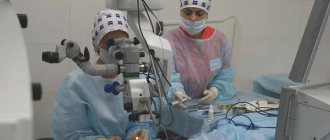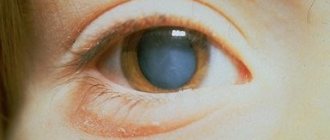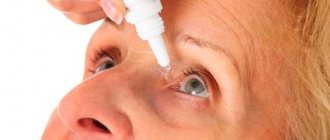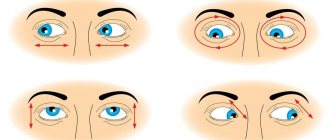What should you eat if you have cataracts? Nutrition for cataracts involves avoiding certain foods. As much as possible, you should include “correct” dishes in your diet. Food should be healthy. If you have cataracts, you should avoid eating fatty foods. They not only provoke the development of the disease, but also become the cause of relapse after long-term drug treatment.
It should be understood that a disease such as cataracts is an ever-worsening disease. The only true treatment is surgery.
Neutralize free radicals
Cataracts of the eye are insidious in that they can appear at any age. In older people, the disease is provoked by the aging processes of eye tissue, in young people - by eye injuries and heredity.
If food is correct throughout life, then even with a genetic predisposition, the development of pathology can be avoided.
Free radicals are molecules that are particularly active.
Action of free radicals:
- They “take” electrons from other molecules, which, in turn, immediately become harmful molecules. This process can take forever.
- The more harmful molecules there are, the faster the process of severe oxidation occurs in the body.
The body needs free radicals, but in very small quantities. They help the immune system destroy harmful infections. But as soon as their number increases, various pathologies immediately begin to develop in the body. And eye cataracts are not the only disease caused by harmful molecules. The consequences of a large number of harmful molecules are cancer, stroke, heart attack, premature aging of the body.
Free radicals enter the body in most cases with unhealthy foods. But there are other ways to penetrate them into the blood.
Interesting! In 10 minutes, while a person fills up a vehicle at a gas station, he receives a dose of gasoline fumes that contains an amount of free radicals that his ancestors did not receive in their entire lives.
A diet for clouding the lens of the eye involves excluding foods that contain harmful molecules. There are useful products that can help get rid of them. Antioxidants neutralize the effects of harmful molecules, sweeping them out of the body like a broom.
Antioxidants are also called antioxidants. Contained in many foods.
Actions of antioxidants:
- Block harmful molecules.
- These molecules coagulate and remove them from the body, preventing the development of pathologies, including cataracts.
Biological supplements for lens clouding
To cleanse the body and resume full absorption of nutrients, dietary supplements were created. Their feature is easy digestibility and rapid penetration into the blood, from where they are well accepted by the body. This is due to the plant origin of the components.
Preventive dietary supplements for cataracts:
- Antiox+, Pax+ forte. Preparations based on grape pomace extract with selenium, zinc, beta-carotene and vitamin E. They normalize metabolism in the lens, preventing and slowing down the development of cataracts.
- Biozinc. The product contains zinc lactate, and this is the most digestible form of the substance. The body needs zinc to maintain immunity and gastrointestinal tract function, enhances the work of enzymes, accelerates the production of proteins, nucleic acids and collagen. Thanks to the influence of zinc, the lens does not dehydrate and remains transparent and elastic.
- Spirulina. The drug is made from small algae that grows in the waters of China. It contains a lot of “light” protein, as well as useful amino acids that are not produced by the human body. Spirulina is a source of selenium, calcium, phosphorus, iron, magnesium, beta-carotene, chlorophyll, and polyunsaturated omega-6 fats.
- Blueberry forte. The supplement contains zinc, lutein, vitamins B and C, and blueberry extract. Thanks to this composition, the drug effectively improves microcirculation, strengthens blood vessels, and eliminates oxygen starvation of tissues. Blueberry forte is prescribed for the prevention of night blindness, vision impairment and cataracts.
- Will direct. These are vitamins for the eyes, which help reduce their fatigue, good adaptation to light and darkness. The drug contains zinc, blueberry extract, ginkgo biloba and eyebright, as well as vitamins A, B, C and P.
Today you can choose a supplement according to your indications. You can take any medication or prophylactic drug only with the permission of your doctor. Dietary supplements cannot be regarded as a panacea for cataracts.
Vitamins to help
The most powerful antioxidants include vitamin E, C and carotenoids (lutein and zeaxanthin). The last two substances are part of the eye lens. They prevent the negative effects of free radicals and do not allow them to change the structure of the lens.
As soon as there are fewer useful elements, the process of cataract development immediately begins. It is clear that food should contain the maximum amount of antioxidants.
Daily intake of antioxidants for cataracts:
- Vitamin C. Men - up to 100 mg, women - up to 80 mg, smoking women and men - up to 40 mg.
- Vitamin E. Regardless of gender, people should consume up to 20 mg of natural vitamin every day, up to 23 mg of synthesized vitamin.
- Lutein, zeaxanthin – up to 7 mg.
Vitamin C is found in:
- lemon;
- orange and freshly squeezed orange juice (store-bought juices may also contain free radicals, so the diet requires the use of freshly prepared drinks);
- grapefruit and freshly squeezed grapefruit juice;
- melon and melon seeds;
- strawberries;
- green sweet pepper;
- broccoli;
- tomato juice;
- fresh and dry rose hips;
- black currant;
- kiwi;
- honey and propolis;
- greenery;
- gooseberries;
- Brussels sprouts;
- green peas;
- Quince;
- radish.
Vitamin E (folic acid) is found in:
- sunflower and butter;
- sunflower seeds;
- almonds, walnuts, peanuts;
- broccoli;
- sea buckthorn;
- apple and pear seeds.
Lutein and zeaxanthin are found in:
- spinach;
- broccoli;
- mustard and dandelion leaves;
- turnip tops;
- green peas;
- citrus fruits;
- peaches;
- apricots;
- melon;
- pumpkin;
- corn;
- apples;
- pomegranates;
- red grapes;
- tomatoes;
- beets
As you can see, the diet should contain foods for cataracts such as vegetables and fruits. But meat products are also not prohibited.
- You can eat chicken, rabbit, beef.
- Seafood and fish are rich in zinc, which also prevents the development of cataracts. When it comes to fish, it is better to give preference to marine species.
When the lens of the eye becomes cloudy, food should be steamed or baked in the oven. It is necessary to remember that many fruits and vegetables, during heat treatment, lose some of their beneficial elements. Therefore, it is better to give preference, for example, to fresh strawberries rather than compotes made from them.
It is better to eat food fractionally, that is, in small portions, but often. To ensure that the diet does not harm a person, you should consult a nutritionist. Because many foods can cause allergies.
What drinks will help destroy free radicals that damage the eyes:
- green and herbal tea (thyme, chamomile, oregano, St. John's wort, strawberry - these plants are the strongest antioxidants in nature, which means they can suppress the action of free radicals);
- mineral still water;
- freshly squeezed juices - you can drink them in unlimited quantities (the juice of pumpkin, carrots, beets, cucumber, spinach, parsley is especially useful).
Juices should be prepared and drunk immediately. After the drink sits for 2-3 hours, it already loses half of its beneficial properties.
General information
Cataracts are an eye disease that is most common among older people.
The lens of the human eye is a kind of “natural lens” that transmits and refracts rays of light. It is found in the human eyeball and is located between the vitreous body and the iris. When a person is young, his lens is elastic and transparent. As a result, the shape of the lens can change without problems, and vision focuses perfectly on both near and distant objects. When you develop a cataract, there is a process of either partial or complete clouding of the lens. Consequently, the transparency of the lens is lost, and not all light rays can enter the eye. In this case, vision deteriorates, objects that a person sees become blurry and indistinct. Over time, the disease progresses, as a result of which the clouding occupies a larger area. And if treatment is not carried out in a timely manner, the person may lose his vision completely.
The disease can affect a person of any age. At the same time, there are several different forms of cataracts: congenital , complicated , traumatic , radiation , as well as cataracts that are provoked by common diseases. However, most often patients are diagnosed with age-related cataracts - a disease characteristic of people who have crossed the fifty-year mark. There is evidence that about 17 million people worldwide suffer from cataracts.
Beta-carotenes for cataracts
Beta-carotene is also an antioxidant. The lack of this substance leads not only to cataracts, but also to night blindness; perforation of the cornea of the eye; chronic inflammatory process of the edges of the eyelids (blepharitis); the process of drying of the corneal conjunctiva (xerophthalmia); damage to the cornea, which causes tissue melting and necrosis (keratomalacia); complete loss of vision.
One molecule of beta-carotene can destroy a thousand molecules of free radicals. In addition, this substance can eliminate the damage caused by free radicals.
Doctors do not recommend consuming synthetically produced beta-carotene in the form of dietary supplements. It is better to give preference to natural products. Natural beta-carotene is much better absorbed in the body.
The highest beta-carotene content is found in:
- boiled carrots (boiled carrots contain more carotene than raw ones);
- greenery;
- apricots;
- turnip;
- cabbage;
- red bell pepper;
- egg yolks;
- butter;
- parsley;
- sour cream;
- liver;
- watermelons;
- sweet potatoes.
It’s not for nothing that mothers, especially girls, say in childhood that they need to eat carrots and parsley to make their eyes beautiful. Such food will help prevent the development of various ophthalmic pathologies, including cataracts. All of the above products must be included in the diet, especially by people who are at risk.
Congenital cataract
Due to changes occurring in the lens, blindness and low vision are observed in children. Such changes can be either acquired or congenital . Today, congenital cataracts are one of the most common visual defects in newborns. The disease can affect one or both eyes. At the same time, other pathologies may accompany the disease.
It is customary to distinguish several different types of congenital cataracts. With capsular cataracts, isolated clouding of the anterior or posterior lens bag is observed. In this case, the cloudiness can have different shapes and sizes. Depending on the amount of opacification of the capsule, the level of vision decreases. This pathology often develops in connection with diseases that a woman suffered during pregnancy or due to intrauterine inflammation.
With polar cataracts, the disease affects both the capsule and the substance of the lens at the posterior or anterior poles. In this case, bilateral cataracts predominate. The size and shape of the lesion can be varied.
Most often in infants, layered cataracts occur, which are mainly bilateral. The lesion in this form of the disease is located in the center, around the nucleus. In this case, there is always a decrease in vision.
Nuclear cataracts appear in both eyes. This pathology is often in the nature of a hereditary disease. Vision decreases very noticeably. However, if the opacification is limited to the embryonic nucleus, the visual problems may be minor.
Complete both eyes. In this case, the symptoms of cataracts can be varied. They directly depend on the degree of clouding of the lens observed in the patient. If a cataract affects the entire lens, it becomes cloudy. The child has only the sensation of light. This pathology develops both before the birth of a child and in the first months of his life. Complete cataracts are often combined with other eye pathologies. Sometimes complete cataracts resolve on their own. In this case, a film is present in the area of the pupil (membranous cataract develops).
Complicated cataracts appear in a child due to viral rubella , galactosemia , diabetes and other ailments. Very often it is accompanied by other severe pathologies.
The causes of congenital cataracts are metabolic disorders, the presence of diabetes mellitus in the mother, and infectious diseases in the first trimester of pregnancy.
Doctors determine congenital cataracts by certain visible signs. A cloudiness resembling a disk or dot is visible in the child's pupil area. There may also be visible diffuse pupillary opacification. In addition, with cataracts, the child experiences nystagmus and strabismus . Upon reaching the age of two months, the child cannot focus his gaze on people’s faces and objects; he does not have a tracking reaction for a certain thing. When looking at a toy, a child always turns to it with the same eye.
In addition, with congenital cataracts there may be no visible symptoms of the disease at all. Therefore, the child should be shown to an ophthalmologist without fail.
Foods that trigger the development of cataracts
- The No. 1 food that causes cataracts is sugar. The lens is a gel-like transparent substance. When the level of glucose in the blood increases, this element of the eye is able to “sugarify”. If a person’s diet includes a lot of sweet dishes, and he likes to indulge in sweet tea and cakes, then glucose will concentrate in the lens, causing it to become cloudy. Older people especially need to monitor their sugar intake. You also need to exclude confectionery and chocolates.
- In second place are fried and fatty foods. This food contains a huge amount of free radicals and cholesterol. Moreover, even healthy foods, such as eggs, can contain harmful elements. If a person, after frying eggs or a piece of lard in a frying pan, sees a black crust, then he should know that by eating such a dish he will saturate his body with free radicals. By the way, experts believe that lard is a harmful product. But as the truth goes, everything is useful in moderation. If you have cataracts, you are allowed to eat no more than 50 g of lard per day. In this case, harmful cholesterol will not be produced. In this amount, lard is even useful.
- Alcoholic drinks occupy third place. Not only does ethanol kill all vitamins and nutrients in the body, but when consumed in excess, it promotes the formation of free radicals. People suffering from cataracts or those who have undergone lens replacement surgery should avoid drinking alcohol as much as possible. The monthly dose is no more than 150 ml (meaning dry white wine).
For early cataracts, diet will help prevent vision deterioration. But ultimately the disease will still progress. Therefore, it is better not to hesitate and have surgery right away.
Examples of vitamin dishes to support eye health
Zrazy from carrots and prunes
Rinse the prunes thoroughly and add hot water, leaving to swell for 30 minutes. Then cut in half. Peel the carrots, grate them on a coarse grater, simmer in milk over low heat until done and add semolina. Mix thoroughly and simmer for about 10 minutes. Let cool, add egg, butter, sugar, mix again. Then you can form zrazy, putting prunes inside, roll in flour, place on a baking sheet greased with vegetable oil, pour in sour cream and bake in the oven until ready.
For one serving: carrots 200 g, prunes 50 g, milk 150 ml, semolina 10 g, egg, flour 10 g, sugar 10 g, sour cream to taste, vegetable oil - for greasing the baking sheet.
Treatment of congenital cataracts
With the help of early diagnosis, it is possible to select an individual treatment system for the child that will give the most noticeable effect. If the cataract is located in such a way that the child's vision can develop normally, then treatment may not be required at all. However, in this case, regular monitoring is necessary. If vision development is obstructed, cataracts must be removed as soon as possible. Since conservative treatment is ineffective in this case, surgical therapy should be used.
How to maintain vision before surgery
Recent research shows that vegetarians are less likely to have cataracts. By consuming a large amount of vegetables and fruits, the body receives a sufficient amount of vitamins and minerals, and normal nutrition of tissues and cells, including eye tissues, is ensured.
Dietary recommendations for cataracts:
- reduce the amount of sugar and baked goods,
- do not abuse red meat and fatty fish,
- refuse marinades, pickles, sauces and smoked meats,
- ignore excessively salty, floury, sweet and fatty foods,
- drink less coffee and strong tea,
- replace carbonated drinks with teas.
People with cataracts should give preference to green tea and herbal infusions. Chamomile, St. John's wort, thyme, oregano and strawberries are suitable for strengthening the visual system. Natural fresh juices and still mineral water will be beneficial. You need to drink 1.5 liters of fluid per day, and in the summer or with prolonged eye strain - 1.8-2 liters.
Over the years of life, the human body is replenished with waste, the intestinal walls are covered with toxins, which interfere with the absorption of beneficial elements. Even following a balanced diet, a person lacks vitamins and minerals, which has a bad effect on health, including the condition of the visual system. You can get additional benefits from dietary supplements.
Drop therapy can be considered as a complement to proper nutrition and eye protection from the sun. A good remedy can be prepared at home.
Drops for the prevention of cataracts
- Honey. For cataracts, honey drops in spring or distilled water can be useful. This remedy will help relieve pain, slow down cloudiness and moisturize the mucous membrane. Honey drops are an excellent prevention of eye inflammation; they nourish all elements of the eyeball. To prepare the drops, mix half linden honey and half distilled water. The product is instilled several times every day. The effective result is noticeable only after 2 months of treatment.
- Geranium. To prepare drops with geranium juice, you must follow a similar recipe. The product is instilled twice a day. Treatment in this case will be long-term, and the results will become noticeable after 3-4 months.
Patients are advised to wear side-paneled sunglasses prior to surgery. However, simple dark glasses will not be of any use, even with the highest quality glass and plastic lenses. You need to buy glasses with special lenses that block the ultraviolet spectrum.
People with a tendency to ophthalmic pathologies should wear hats with wide brims on sunny days that provide shade on the face, neck and even shoulders. On the beach you should refrain from prolonged exposure to the sun, but rest in the shade is welcome.
Causes of cataracts
The main reason for the manifestation of cataracts is the aging of the human body, as a result of which a number of endocrine disorders occur. Metabolism is disrupted , vitamin deficiency , diabetes mellitus and other diseases appear. In addition, the causes of cataracts are considered to be the influence of hereditary predisposition, various eye diseases, injuries, and long-term treatment with certain medications. Cataracts are also often caused by eye diseases - glaucoma , high myopia, etc. Microwave and ultraviolet irradiation, high radiation, environmental factors, and toxic poisoning can also have a negative impact .
Possible complications
In 99 cases out of 100, the operation takes place without any problems. Even elderly patients tolerate surgery absolutely normally and recover quickly, gaining the opportunity to see well again.
But, of course, in isolated and very rare cases complications may occur. Especially if the patient neglects the doctor’s recommendations:
- the appearance of severe inflammation or swelling;
- regular increase in intraocular pressure;
- vitreous hemorrhage;
- shift of the artificial lens;
- retinal detachment;
- dystrophic changes in the cornea.
Any negative changes should be discussed with your doctor immediately. If you feel unwell, your eyes hurt, spots, dots, or threads appear before your eyes, then you should immediately seek medical help from your doctor.
Diso Nutrimoon
Protein for treatment and rehabilitation
An easily digestible, tasteless protein mixture, a source of proteins and amino acids necessary for the body to fight illness, recover from injuries, illnesses and operations.
More details
Limit the intake of saturated animal fats and simple carbohydrates. The carbohydrate part of the diet should be represented mainly by vegetables, fruits, cereals and whole grains.
The menu must contain products that are sources of polyunsaturated fatty acids: fatty fish, unrefined vegetable oils.
It is also important to include in your diet foods high in lutein and zeaxanthin, which effectively inhibit the development of cataracts (spinach, lettuce, peas, eggs, bell peppers).
Vitamins A, C, E, group B, contained in fresh vegetables, fruits, and grains, will also help maintain the health of the organ of vision.
List of recommended products and dishes
- Lean meat (rabbit, beef), poultry (chicken, turkey), fish
- Beef liver
- Fatty fish (2-3 times a week): mackerel, tuna, salmon, sardine
- Eggs (in moderation)
- Seafood
- Milk and fermented milk drinks
- Low-fat cottage cheese, hard cheese
- Unrefined vegetable oils
- Cereals and whole grains
- Legumes (lentils, peas, beans)
- Vegetables, fruits and berries
- Nuts (walnuts, peanuts, hazelnuts) and seeds
- Dried fruits











